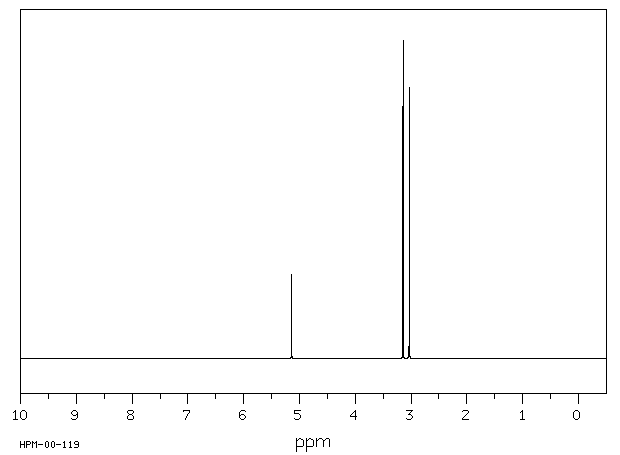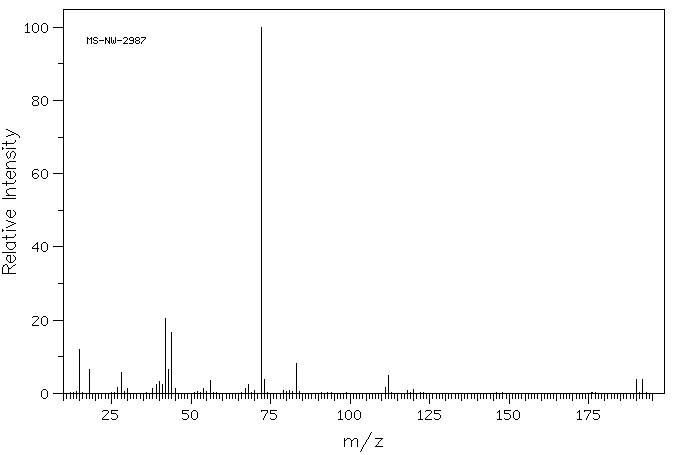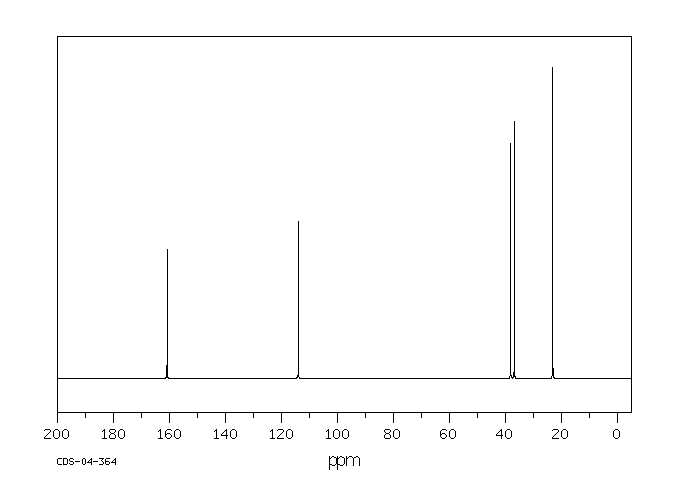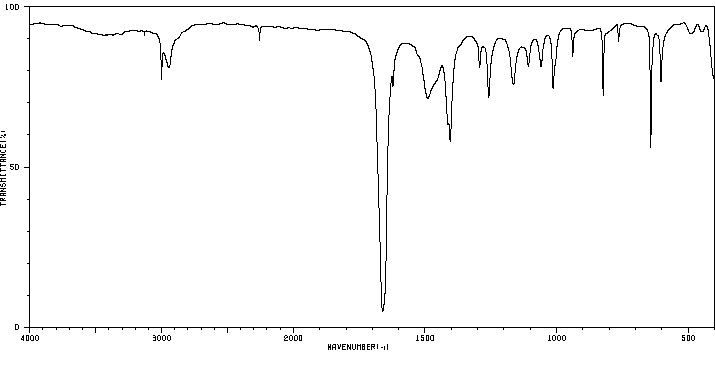2-溴-2-氰基-N,N-二甲基乙酰胺 | 15430-62-3
中文名称
2-溴-2-氰基-N,N-二甲基乙酰胺
中文别名
2-(N,N-二甲基氨基甲酰基)-2-溴乙腈;N,N-二甲基-2-溴-2-氰基乙酰胺
英文名称
N,N-dimethyl-2-bromo-3-nitrilopropionamide
英文别名
2-Bromo-2-cyano-N,N-dimethylacetamide;2-Bromo-2-cyano-N,N-dimethylacetamid;2-Brom-2-cyan-N,N-dimethyl-acetamid
CAS
15430-62-3
化学式
C5H7BrN2O
mdl
——
分子量
191.027
InChiKey
HLAJXHYCSPHGGI-UHFFFAOYSA-N
BEILSTEIN
——
EINECS
——
-
物化性质
-
计算性质
-
ADMET
-
安全信息
-
SDS
-
制备方法与用途
-
上下游信息
-
文献信息
-
表征谱图
-
同类化合物
-
相关功能分类
-
相关结构分类
物化性质
-
熔点:57°C
-
沸点:135 °C / 3mmHg
-
密度:1.560±0.06 g/cm3(Predicted)
计算性质
-
辛醇/水分配系数(LogP):0.5
-
重原子数:9
-
可旋转键数:1
-
环数:0.0
-
sp3杂化的碳原子比例:0.6
-
拓扑面积:44.1
-
氢给体数:0
-
氢受体数:2
安全信息
-
安全说明:S26,S36/37/39
-
危险类别码:R36/37/38
-
海关编码:2926909090
SDS
2-Bromo-2-cyano-N,N-dimethylacetamide
SAFETY DATA SHEET
Section 1. IDENTIFICATION OF THE SUBSTANCE OR MIXTURE AND OF THE SUPPLIER
Product name: 2-Bromo-2-cyano-N,N-dimethylacetamide
Section 2. HAZARDS IDENTIFICATION
Classification of the GHS
PHYSICAL HAZARDS Not classified
HEALTH HAZARDS
Category 4
Acute toxicity (Oral)
Acute toxicity (Dermal) Category 4
Category 4
Acute toxicity (Inhalation)
Skin corrosion/irritation Category 2
Category 2A
Serious eye damage/eye irritation
ENVIRONMENTAL HAZARDS Not classified
GHS label elements
Pictograms or hazard symbols
Signal word Warning
Hazard statement Harmful by inhalation, in contact with skin and if swallowed
Causes skin irritation
Causes serious eye irritation
Precautionary statements
[Prevention] Avoid breathing.
Use only outdoors or in a well-ventilated area.
Do not eat, drink or smoke when using this product.
Wash hands thoroughly after handling.
Wear protective gloves and eye/face protection.
IF INHALED: Remove victim to fresh air and keep at rest in a position comfortable for
[Response]
breathing. Call a POISON CENTER or doctor/physician if you feel unwell.
IF SWALLOWED: Call a POISON CENTER or doctor/physician if you feel unwell.
Rinse mouth.
IF IN EYES: Rinse cautiously with water for several minutes. Remove contact lenses,
if present and easy to do. Continue rinsing.
If eye irritation persists: Get medical advice/attention.
IF ON SKIN: Gently wash with plenty of soap and water.
If skin irritation occurs: Get medical advice/attention.
Wash contaminated clothing before reuse.
Call a POISON CENTER or doctor/physician if you feel unwell.
[Disposal] Dispose of contents/container through a waste management company authorized by
the local government
2-Bromo-2-cyano-N,N-dimethylacetamide
Section 3. COMPOSITION/INFORMATION ON INGREDIENTS
Substance/mixture: Substance
Component(s): 2-Bromo-2-cyano-N,N-dimethylacetamide
Percent: >90.0%(GC)
CAS Number: 15430-62-3
Synonyms: N,N-Dimethyl-2-bromo-2-cyanoacetamide , 2-(N,N-Dimethylcarbamoyl)-2-
bromoacetonitrile
Chemical Formula: C5H7BrN2O
Section 4. FIRST AID MEASURES
Inhalation: Remove victim to fresh air and keep at rest in a position comfortable for breathing.
Call a POISON CENTER or doctor/physician if you feel unwell.
Skin contact: Remove/Take off immediately all contaminated clothing. Gently wash with plenty of
soap and water. If skin irritation or rash occurs: Get medical advice/attention.
Eye contact: Rinse cautiously with water for several minutes. Remove contact lenses, if present
and easy to do. Continue rinsing. If eye irritation persists: Get medical
advice/attention.
Ingestion: Call a POISON CENTER or doctor/physician if you feel unwell. Rinse mouth.
Protection of first-aiders: A rescuer should wear personal protective equipment, such as rubber gloves and air-
tight goggles.
Section 5. FIRE-FIGHTING MEASURES
Suitable extinguishing Dry chemical, foam, water spray, carbon dioxide.
media:
Specific hazards: Take care as it may decompose upon combustion or in high temperatures to
generate poisonous fume.
Specific methods: Fire-extinguishing work is done from the windward and the suitable fire-extinguishing
method according to the surrounding situation is used. Uninvolved persons should
evacuate to a safe place. In case of fire in the surroundings: Remove movable
containers if safe to do so.
Special protective When extinguishing fire, be sure to wear personal protective equipment.
equipment for firefighters:
Section 6. ACCIDENTAL RELEASE MEASURES
Use personal protective equipment. Keep people away from and upwind of spill/leak.
Personal precautions,
protective equipment and Entry to non-involved personnel should be controlled around the leakage area by
emergency procedures: roping off, etc.
Environmental precautions: Prevent product from entering drains.
Methods and materials for Sweep dust to collect it into an airtight container, taking care not to disperse it.
containment and cleaning Adhered or collected material should be promptly disposed of, in accordance with
up: appropriate laws and regulations.
Section 7. HANDLING AND STORAGE
Handling
Technical measures: Handling is performed in a well ventilated place. Wear suitable protective equipment.
Prevent dispersion of dust. Wash hands and face thoroughly after handling.
Use a local exhaust if dust or aerosol will be generated.
Advice on safe handling: Avoid contact with skin, eyes and clothing.
Storage
Storage conditions: Keep container tightly closed. Store in a cool and dark place.
Store under inert gas.
Store locked up.
Store away from incompatible materials such as oxidizing agents.
Packaging material: Law is followed.
2-Bromo-2-cyano-N,N-dimethylacetamide
Section 8. EXPOSURE CONTROLS / PERSONAL PROTECTION
Engineering controls: Install a closed system or local exhaust as possible so that workers should not be
exposed directly. Also install safety shower and eye bath.
Personal protective equipment
Respiratory protection: Dust respirator, self-contained breathing apparatus(SCBA), supplied air respirator,
etc. Use respirators approved under appropriate government standards and follow
local and national regulations.
Hand protection: Impervious gloves.
Safety goggles. A face-shield, if the situation requires.
Eye protection:
Skin and body protection: Impervious protective clothing. Protective boots, if the situation requires.
Section 9. PHYSICAL AND CHEMICAL PROPERTIES
Physical state (20°C): Solid
crystal - powder
Form:
Color: White - Pale yellow
No data available
Odor:
pH: No data available
Melting point/freezing point:57 °C
Boiling Point/Range: 135 °C/0.4kPa
Flash Point: No data available
Explosive limits
No data available
Lower:
Upper: No data available
No data available
Density:
Solubility: Soluble in : Methanol
Section 10. STABILITY AND REACTIVITY
Stability: Stable under proper conditions.
Reactivity: No special reactivity has been reported.
Conditions to avoid: Air-sensitive
Incompartible materials: oxidizing agents
Hazardous Decomposition Carbon monoxide, Carbon dioxide, Nitrogen oxides (NOx), Hydrogen bromide,
Hydrogen cyanide
Products:
Section 11. TOXICOLOGICAL INFORMATION
Acute Toxicity: No data available
Skin corrosion/irritation: No data available
Serious eye No data available
damage/irritation:
Germ cell mutagenicity: No data available
Carcinogenicity:
IARC = No data available
No data available
NTP =
Reproductive toxicity: No data available
Section 12. ECOLOGICAL INFORMATION
Ecotoxicity:
Fish: No data available
Crustacea: No data available
Algae: No data available
Persistence / degradability: No data available
Bioaccumulative No data available
potential(BCF):
Mobillity in soil
log Pow: No data available
Soil adsorption (Koc): No data available
2-Bromo-2-cyano-N,N-dimethylacetamide
Section 12. ECOLOGICAL INFORMATION
Henry's Law No data available
constant(PaM3/mol):
Section 13. DISPOSAL CONSIDERATIONS
Recycle to process, if possible. Consult your local regional authorities. You may be able to dissolve or mix material
with a combustible solvent and burn in a chemical incinerator equipped with an afterburner and scrubber system.
Observe all federal, state and local regulations when disposing of the substance.
Section 14. TRANSPORT INFORMATION
Hazards Class: Does not correspond to the classification standard of the United Nations
Not Listed
UN-No:
Section 15. REGULATORY INFORMATION
Safe management ordinance of dangerous chemical product (State Council announces on January 26,
2002): Safe use and production, the storage of a dangerous chemical, transport, loading and unloading were
prescribed.
SECTION 16 - ADDITIONAL INFORMATION
N/A
SAFETY DATA SHEET
Section 1. IDENTIFICATION OF THE SUBSTANCE OR MIXTURE AND OF THE SUPPLIER
Product name: 2-Bromo-2-cyano-N,N-dimethylacetamide
Section 2. HAZARDS IDENTIFICATION
Classification of the GHS
PHYSICAL HAZARDS Not classified
HEALTH HAZARDS
Category 4
Acute toxicity (Oral)
Acute toxicity (Dermal) Category 4
Category 4
Acute toxicity (Inhalation)
Skin corrosion/irritation Category 2
Category 2A
Serious eye damage/eye irritation
ENVIRONMENTAL HAZARDS Not classified
GHS label elements
Pictograms or hazard symbols
Signal word Warning
Hazard statement Harmful by inhalation, in contact with skin and if swallowed
Causes skin irritation
Causes serious eye irritation
Precautionary statements
[Prevention] Avoid breathing.
Use only outdoors or in a well-ventilated area.
Do not eat, drink or smoke when using this product.
Wash hands thoroughly after handling.
Wear protective gloves and eye/face protection.
IF INHALED: Remove victim to fresh air and keep at rest in a position comfortable for
[Response]
breathing. Call a POISON CENTER or doctor/physician if you feel unwell.
IF SWALLOWED: Call a POISON CENTER or doctor/physician if you feel unwell.
Rinse mouth.
IF IN EYES: Rinse cautiously with water for several minutes. Remove contact lenses,
if present and easy to do. Continue rinsing.
If eye irritation persists: Get medical advice/attention.
IF ON SKIN: Gently wash with plenty of soap and water.
If skin irritation occurs: Get medical advice/attention.
Wash contaminated clothing before reuse.
Call a POISON CENTER or doctor/physician if you feel unwell.
[Disposal] Dispose of contents/container through a waste management company authorized by
the local government
2-Bromo-2-cyano-N,N-dimethylacetamide
Section 3. COMPOSITION/INFORMATION ON INGREDIENTS
Substance/mixture: Substance
Component(s): 2-Bromo-2-cyano-N,N-dimethylacetamide
Percent: >90.0%(GC)
CAS Number: 15430-62-3
Synonyms: N,N-Dimethyl-2-bromo-2-cyanoacetamide , 2-(N,N-Dimethylcarbamoyl)-2-
bromoacetonitrile
Chemical Formula: C5H7BrN2O
Section 4. FIRST AID MEASURES
Inhalation: Remove victim to fresh air and keep at rest in a position comfortable for breathing.
Call a POISON CENTER or doctor/physician if you feel unwell.
Skin contact: Remove/Take off immediately all contaminated clothing. Gently wash with plenty of
soap and water. If skin irritation or rash occurs: Get medical advice/attention.
Eye contact: Rinse cautiously with water for several minutes. Remove contact lenses, if present
and easy to do. Continue rinsing. If eye irritation persists: Get medical
advice/attention.
Ingestion: Call a POISON CENTER or doctor/physician if you feel unwell. Rinse mouth.
Protection of first-aiders: A rescuer should wear personal protective equipment, such as rubber gloves and air-
tight goggles.
Section 5. FIRE-FIGHTING MEASURES
Suitable extinguishing Dry chemical, foam, water spray, carbon dioxide.
media:
Specific hazards: Take care as it may decompose upon combustion or in high temperatures to
generate poisonous fume.
Specific methods: Fire-extinguishing work is done from the windward and the suitable fire-extinguishing
method according to the surrounding situation is used. Uninvolved persons should
evacuate to a safe place. In case of fire in the surroundings: Remove movable
containers if safe to do so.
Special protective When extinguishing fire, be sure to wear personal protective equipment.
equipment for firefighters:
Section 6. ACCIDENTAL RELEASE MEASURES
Use personal protective equipment. Keep people away from and upwind of spill/leak.
Personal precautions,
protective equipment and Entry to non-involved personnel should be controlled around the leakage area by
emergency procedures: roping off, etc.
Environmental precautions: Prevent product from entering drains.
Methods and materials for Sweep dust to collect it into an airtight container, taking care not to disperse it.
containment and cleaning Adhered or collected material should be promptly disposed of, in accordance with
up: appropriate laws and regulations.
Section 7. HANDLING AND STORAGE
Handling
Technical measures: Handling is performed in a well ventilated place. Wear suitable protective equipment.
Prevent dispersion of dust. Wash hands and face thoroughly after handling.
Use a local exhaust if dust or aerosol will be generated.
Advice on safe handling: Avoid contact with skin, eyes and clothing.
Storage
Storage conditions: Keep container tightly closed. Store in a cool and dark place.
Store under inert gas.
Store locked up.
Store away from incompatible materials such as oxidizing agents.
Packaging material: Law is followed.
2-Bromo-2-cyano-N,N-dimethylacetamide
Section 8. EXPOSURE CONTROLS / PERSONAL PROTECTION
Engineering controls: Install a closed system or local exhaust as possible so that workers should not be
exposed directly. Also install safety shower and eye bath.
Personal protective equipment
Respiratory protection: Dust respirator, self-contained breathing apparatus(SCBA), supplied air respirator,
etc. Use respirators approved under appropriate government standards and follow
local and national regulations.
Hand protection: Impervious gloves.
Safety goggles. A face-shield, if the situation requires.
Eye protection:
Skin and body protection: Impervious protective clothing. Protective boots, if the situation requires.
Section 9. PHYSICAL AND CHEMICAL PROPERTIES
Physical state (20°C): Solid
crystal - powder
Form:
Color: White - Pale yellow
No data available
Odor:
pH: No data available
Melting point/freezing point:57 °C
Boiling Point/Range: 135 °C/0.4kPa
Flash Point: No data available
Explosive limits
No data available
Lower:
Upper: No data available
No data available
Density:
Solubility: Soluble in : Methanol
Section 10. STABILITY AND REACTIVITY
Stability: Stable under proper conditions.
Reactivity: No special reactivity has been reported.
Conditions to avoid: Air-sensitive
Incompartible materials: oxidizing agents
Hazardous Decomposition Carbon monoxide, Carbon dioxide, Nitrogen oxides (NOx), Hydrogen bromide,
Hydrogen cyanide
Products:
Section 11. TOXICOLOGICAL INFORMATION
Acute Toxicity: No data available
Skin corrosion/irritation: No data available
Serious eye No data available
damage/irritation:
Germ cell mutagenicity: No data available
Carcinogenicity:
IARC = No data available
No data available
NTP =
Reproductive toxicity: No data available
Section 12. ECOLOGICAL INFORMATION
Ecotoxicity:
Fish: No data available
Crustacea: No data available
Algae: No data available
Persistence / degradability: No data available
Bioaccumulative No data available
potential(BCF):
Mobillity in soil
log Pow: No data available
Soil adsorption (Koc): No data available
2-Bromo-2-cyano-N,N-dimethylacetamide
Section 12. ECOLOGICAL INFORMATION
Henry's Law No data available
constant(PaM3/mol):
Section 13. DISPOSAL CONSIDERATIONS
Recycle to process, if possible. Consult your local regional authorities. You may be able to dissolve or mix material
with a combustible solvent and burn in a chemical incinerator equipped with an afterburner and scrubber system.
Observe all federal, state and local regulations when disposing of the substance.
Section 14. TRANSPORT INFORMATION
Hazards Class: Does not correspond to the classification standard of the United Nations
Not Listed
UN-No:
Section 15. REGULATORY INFORMATION
Safe management ordinance of dangerous chemical product (State Council announces on January 26,
2002): Safe use and production, the storage of a dangerous chemical, transport, loading and unloading were
prescribed.
SECTION 16 - ADDITIONAL INFORMATION
N/A
上下游信息
-
上游原料
中文名称 英文名称 CAS号 化学式 分子量 N,N-二甲基氰乙酰胺 N,N-dimethylcyanoacetamide 7391-40-4 C5H8N2O 112.131
反应信息
-
作为反应物:描述:2-溴-2-氰基-N,N-二甲基乙酰胺 以 1,4-二氧六环 、 乙腈 为溶剂, 反应 48.0h, 生成 2-amino-1,5,6-tricyano-4,4-bis[(cyclohexylideneamino)oxy]-N,N-dimethyl-3-azabicyclo[3.1.0]hex-2-ene-6-carboxamide参考文献:名称:Siaka; Lukin; Nasakin, Russian Journal of Organic Chemistry, 1999, vol. 35, # 2, p. 269 - 274摘要:DOI:
-
作为产物:描述:参考文献:名称:Monobromination of Cyanoacetamides and Amidinoacetamide with Molecular Bromine摘要:DOI:10.1248/cpb.22.965
文献信息
-
N-acylsulfonamide apoptosis promoters申请人:——公开号:US20020055631A1公开(公告)日:2002-05-09N-Benzoyl arylsulfonamides having the formula 1 are BCL-Xl inhibitors and are useful for promoting apoptosis. Also disclosed are BCL-Xl inhibiting compositions and methods of promoting apoptosis in a mammal.
-
N-Acylsulfonamide apoptosis promoters申请人:——公开号:US20020086887A1公开(公告)日:2002-07-04N-Benzoyl arylsulfonamides having the formula 1 Are BCL-X1 inhibitors and are useful for promoting apoptosis. Also disclosed are BCL-X1 inhibiting compositions and methods of promoting apoptosis in a mammal.
-
A Convenient Synthesis of Dialkyl (<i>E</i>)-2,3-Dicyanobutendioates作者:Yoichi Yamada、Heinosuke YasudaDOI:10.1055/s-1990-27009日期:——Dialkyl (E)-2,3-dicyanobutendioates 4, potentially useful intermediates for the synthesis of a wide variety of heterocyclic compounds, are conveniently prepared by the reaction of alkyl bromocyanoacetates 2 with potassium thiocyanate in acetonitrile followed by treatment with water. The starting alkyl bromocyanoacetates are prepared by the photochemical reaction of the appropriate alkyl cyanoacetate with bromine in carbon tetrachloride.
-
Enantioselective α-Alkylation of Aldehydes by Photoredox Organocatalysis: Rapid Access to Pharmacophore Fragments from β-Cyanoaldehydes作者:Eric R. Welin、Alexander A. Warkentin、Jay C. Conrad、David W. C. MacMillanDOI:10.1002/anie.201503789日期:2015.8.10The combination of photoredox catalysis and enamine catalysis has enabled the development of an enantioselective α‐cyanoalkylation of aldehydes. This synergistic catalysis protocol allows for the coupling of two highly versatile yet orthogonal functionalities, allowing rapid diversification of the oxonitrile products to a wide array of medicinally relevant derivatives and heterocycles. This methodology
-
N-ACYLSULFONAMIDE APOPTOSIS PROMOTERS申请人:Augeri David J.公开号:US20090137585A1公开(公告)日:2009-05-28N-Benzoyl arylsulfonamides having the formula are BCL-Xl inhibitors and are useful for promoting apoptosis. Also disclosed are BCL-Xl inhibiting compositions and methods of promoting apoptosis in a mammal.
表征谱图
-
氢谱1HNMR
-
质谱MS
-
碳谱13CNMR
-
红外IR
-
拉曼Raman
-
峰位数据
-
峰位匹配
-
表征信息
同类化合物
(甲基3-(二甲基氨基)-2-苯基-2H-azirene-2-羧酸乙酯)
(±)-盐酸氯吡格雷
(±)-丙酰肉碱氯化物
(d(CH2)51,Tyr(Me)2,Arg8)-血管加压素
(S)-(+)-α-氨基-4-羧基-2-甲基苯乙酸
(S)-阿拉考特盐酸盐
(S)-赖诺普利-d5钠
(S)-2-氨基-5-氧代己酸,氢溴酸盐
(S)-2-[[[(1R,2R)-2-[[[3,5-双(叔丁基)-2-羟基苯基]亚甲基]氨基]环己基]硫脲基]-N-苄基-N,3,3-三甲基丁酰胺
(S)-2-[3-[(1R,2R)-2-(二丙基氨基)环己基]硫脲基]-N-异丙基-3,3-二甲基丁酰胺
(S)-1-(4-氨基氧基乙酰胺基苄基)乙二胺四乙酸
(S)-1-[N-[3-苯基-1-[(苯基甲氧基)羰基]丙基]-L-丙氨酰基]-L-脯氨酸
(R)-乙基N-甲酰基-N-(1-苯乙基)甘氨酸
(R)-丙酰肉碱-d3氯化物
(R)-4-N-Cbz-哌嗪-2-甲酸甲酯
(R)-3-氨基-2-苄基丙酸盐酸盐
(R)-1-(3-溴-2-甲基-1-氧丙基)-L-脯氨酸
(N-[(苄氧基)羰基]丙氨酰-N〜5〜-(diaminomethylidene)鸟氨酸)
(6-氯-2-吲哚基甲基)乙酰氨基丙二酸二乙酯
(4R)-N-亚硝基噻唑烷-4-羧酸
(3R)-1-噻-4-氮杂螺[4.4]壬烷-3-羧酸
(3-硝基-1H-1,2,4-三唑-1-基)乙酸乙酯
(2S,4R)-Boc-4-环己基-吡咯烷-2-羧酸
(2S,3S,5S)-2-氨基-3-羟基-1,6-二苯己烷-5-N-氨基甲酰基-L-缬氨酸
(2S,3S)-3-((S)-1-((1-(4-氟苯基)-1H-1,2,3-三唑-4-基)-甲基氨基)-1-氧-3-(噻唑-4-基)丙-2-基氨基甲酰基)-环氧乙烷-2-羧酸
(2S)-2,6-二氨基-N-[4-(5-氟-1,3-苯并噻唑-2-基)-2-甲基苯基]己酰胺二盐酸盐
(2S)-2-氨基-N,3,3-三甲基-N-(苯甲基)丁酰胺
(2S)-2-氨基-3-甲基-N-2-吡啶基丁酰胺
(2S)-2-氨基-3,3-二甲基-N-(苯基甲基)丁酰胺,
(2S)-2-氨基-3,3-二甲基-N-2-吡啶基丁酰胺
(2S,4R)-1-((S)-2-氨基-3,3-二甲基丁酰基)-4-羟基-N-(4-(4-甲基噻唑-5-基)苄基)吡咯烷-2-甲酰胺盐酸盐
(2R,3'S)苯那普利叔丁基酯d5
(2R)-2-氨基-3,3-二甲基-N-(苯甲基)丁酰胺
(2-氯丙烯基)草酰氯
(1S,3S,5S)-2-Boc-2-氮杂双环[3.1.0]己烷-3-羧酸
(1R,5R,6R)-5-(1-乙基丙氧基)-7-氧杂双环[4.1.0]庚-3-烯-3-羧酸乙基酯
(1R,4R,5S,6R)-4-氨基-2-氧杂双环[3.1.0]己烷-4,6-二羧酸
齐特巴坦
齐德巴坦钠盐
齐墩果-12-烯-28-酸,2,3-二羟基-,苯基甲基酯,(2a,3a)-
齐墩果-12-烯-28-酸,2,3-二羟基-,羧基甲基酯,(2a,3b)-(9CI)
黄酮-8-乙酸二甲氨基乙基酯
黄荧菌素
黄体生成激素释放激素(1-6)
黄体生成激素释放激素 (1-5) 酰肼
黄体瑞林
麦醇溶蛋白
麦角硫因
麦芽聚糖六乙酸酯
麦根酸










